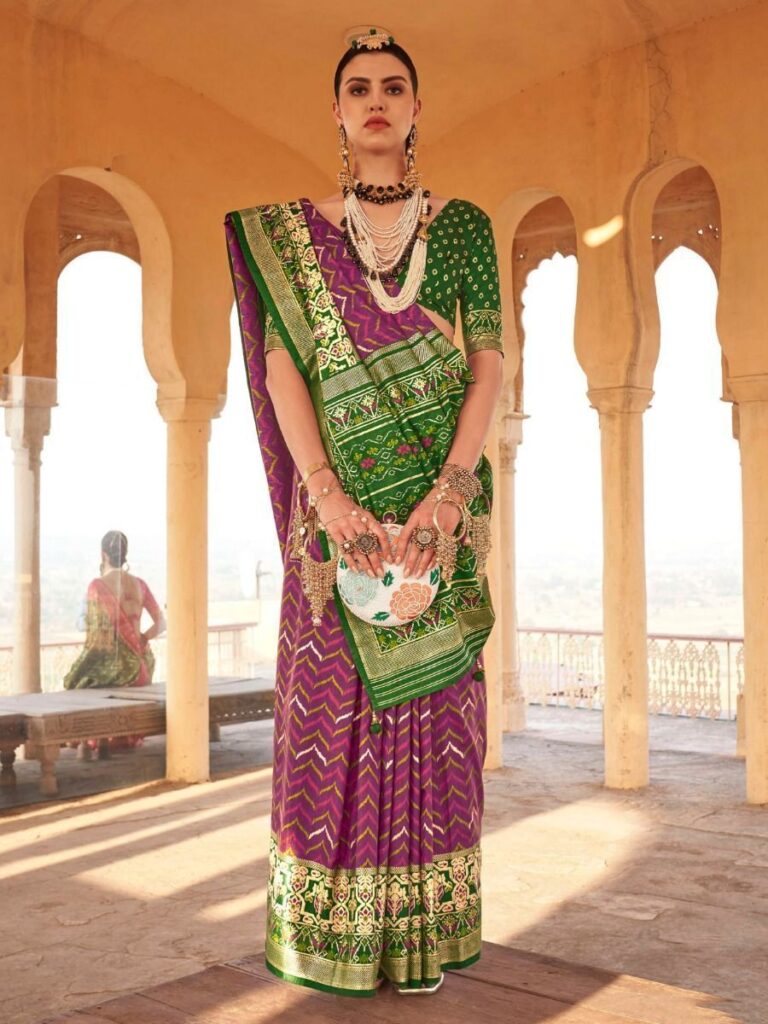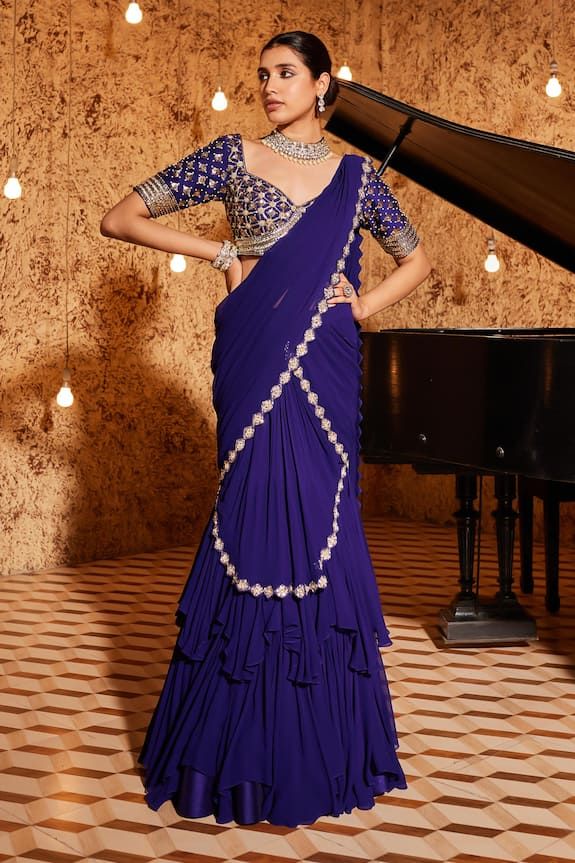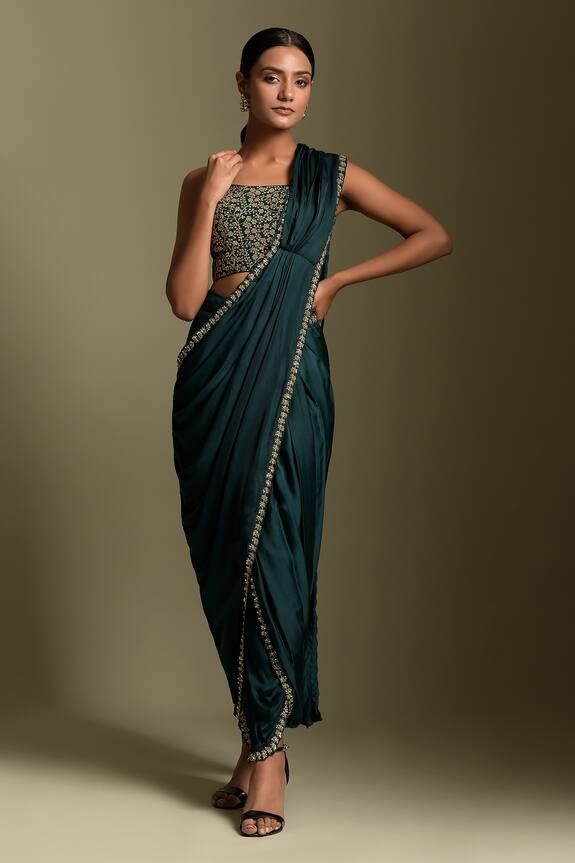Different Saree Draping Styles
Traditional and Modern Techniques
Introduction
The saree is a timeless piece of clothing that exudes grace and elegance. Its versatility makes it a staple in many wardrobes, and the way it is draped can significantly alter the overall look. Whether you’re new to saree draping or looking to experiment with different styles, this guide will walk you through both traditional and modern draping techniques. Each style offers a unique charm, suitable for various occasions and body types.
Traditional Saree Draping Styles
Nivi Style

The Nivi style is the most common saree draping technique in India. Originating from Andhra Pradesh, this style is known for its simplicity and elegance.
To drape a saree in the Nivi style, start by tucking one end of the saree into the petticoat at the right side of your waist. Wrap the saree around your waist and bring it back to the front.
Make pleats in the saree and tuck them into the petticoat at the center. The remaining fabric is then draped over the left shoulder, creating a pallu. This style is perfect for everyday wear and formal occasions, as it is both comfortable and stylish.
Bengali Style
The Bengali style saree draping is distinct and traditional, often seen in Bengali cultural festivities and weddings. To drape a saree in this style, start by tucking the non-pallu end into the petticoat at the right side and wrap it around your waist. Make wide pleats and tuck them into the front. The pallu is then brought around from the back over the left shoulder. It is usually pleated and pinned at the shoulder with a key ring or brooch, giving it a structured look. This style is perfect for adding a touch of cultural heritage to your attire.
Gujarati Style

The Gujarati style, also known as the Seedha Pallu, is a popular draping technique in Gujarat. To achieve this look, start by tucking one end of the saree into the petticoat on the right side. Wrap it around your waist and make pleats, tucking them in at the center. The pallu is then draped over the right shoulder from the back, and the remaining fabric is brought under the left arm and tucked at the back. This style is particularly favored during festive occasions as it allows for easy movement and showcases the saree’s intricate designs on the pallu.
Modern Saree Draping Styles
Mermaid Style

The Mermaid style is a modern and chic way to drape a saree, giving it a gown-like appearance. To drape a saree in this style, start by tucking one end into the petticoat and wrap it around your waist tightly. Make small pleats and tuck them in at the center, creating a snug fit around the hips. The pallu is then draped over the left shoulder, but instead of leaving it loose, it is pleated neatly and pinned to the shoulder. This style is perfect for cocktail parties and evening events, offering a glamorous silhouette.
Pant Style

The Pant style is an innovative and comfortable way to drape a saree, blending traditional and contemporary fashion. To achieve this look, wear a pair of pants or leggings instead of the traditional petticoat. Start by tucking one end of the saree into the waistband of the pants and wrap it around your waist. Make pleats and tuck them in at the front, allowing the saree to flow like a skirt. The pallu is then draped over the shoulder or around the neck like a scarf. This style is ideal for modern workplaces and casual outings, providing ease of movement.
Dhoti Style

The Dhoti style is inspired by traditional men’s dhoti attire and offers a unique and fashionable look for women. To drape a saree in this style, start by folding the saree in half lengthwise. Tuck one end into the petticoat at the center front and bring it between the legs, tucking it at the back to create a dhoti-like effect. The remaining fabric is then draped around the waist and over the shoulder, with the pallu styled as desired. This style is perfect for festive occasions and fashion-forward events, making a bold statement.
Saree Draping for Different Occasions
Weddings
For weddings, traditional saree draping styles like the Nivi, Bengali, and Gujarati are most suitable. These styles not only highlight the rich cultural heritage but also provide a regal look that is perfect for such grand occasions. Embellished sarees with heavy borders and intricate designs work well with these draping techniques. Adding accessories like traditional jewelry, a well-fitted blouse, and a statement pallu can elevate your look.
Office Wear
When it comes to office wear, comfort and elegance are key. The Nivi style and Pant style are excellent choices. Opt for lightweight sarees in subtle colors and minimalistic designs. Pair your saree with a well-fitted blouse that complements the formal setting. Ensure that the draping is neat and secure to maintain a professional appearance throughout the day.
Casual Outings
For casual outings, you can experiment with more relaxed and contemporary draping styles. The Dhoti style and Mermaid style are great options for a fun and stylish look. Choose sarees made from comfortable fabrics like cotton or linen. You can accessorize with trendy jewelry and comfortable footwear to complete the look. These styles allow for easy movement and are perfect for a day out with friends or a casual dinner.
Tips for Perfect Saree Draping
- Choose the Right Fabric: Different draping styles work best with specific fabrics. For instance, cotton sarees are ideal for traditional draping, while chiffon or georgette sarees are better for modern styles.
- Well-Fitted Petticoat: A well-fitted petticoat is crucial for achieving the desired draping style. Ensure that it matches the saree and is tied securely at the waist.
- Pleats: Neatly made pleats can enhance the overall look of your saree. Practice making even pleats and secure them with pins if necessary.
- Accessories: The right accessories can elevate your saree look. Choose jewelry, footwear, and handbags that complement your draping style and the occasion.
- Practice: Perfecting saree draping takes practice. Spend time learning and trying different styles to find what suits you best.
FAQs
Q: How long does it take to drape a saree?
A: The time it takes to drape a saree varies depending on the style and your experience. On average, it can take anywhere from 10 to 30 minutes.
Q: What is the easiest saree draping style for beginners?
A: The Nivi style is considered the easiest for beginners due to its straightforward steps and secure fit.
Q: Can sarees be worn without a petticoat?
A: While traditional saree draping typically requires a petticoat, modern styles like the Pant style allow for draping without one, using pants or leggings instead.
Q: How can I keep my saree pleats in place?
A: Using safety pins to secure the pleats at the waist and shoulder can help keep them in place. Additionally, practice making tight and even pleats for a neat appearance.
Q: Are there specific saree draping styles for different body types?
A: Yes, some styles may flatter certain body types more. For instance, the Mermaid style can accentuate an hourglass figure, while the Nivi style is versatile and suits most body types.
Embrace the elegance of sarees by exploring these various draping styles. Each technique offers a unique way to showcase your personality and celebrate cultural heritage. Whether you’re dressing up for a special occasion or simply enjoying a day out, there’s a saree draping style that’s perfect for you.
Images and Video Source : Pintrest and aza fashion
Read More Post : See More

